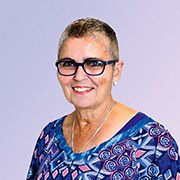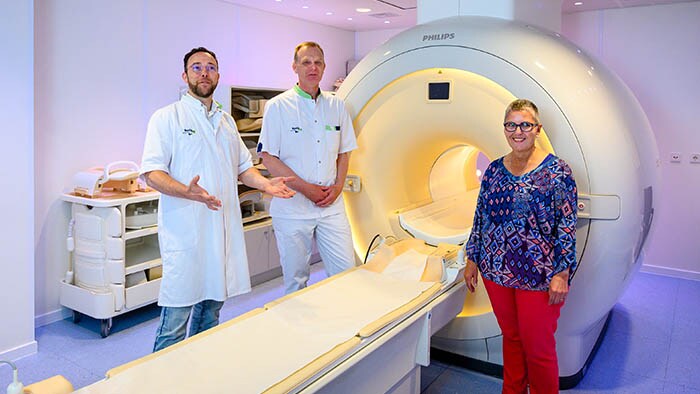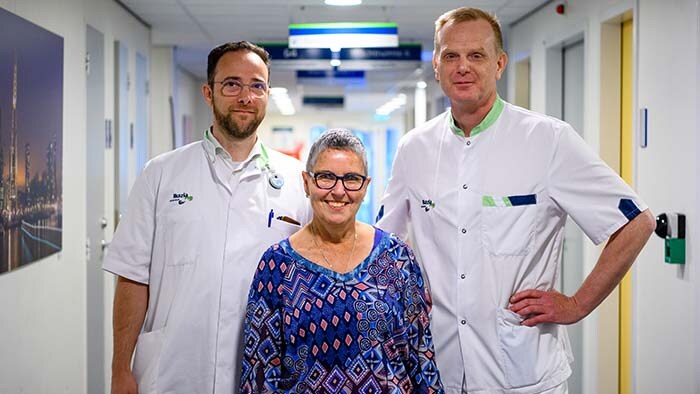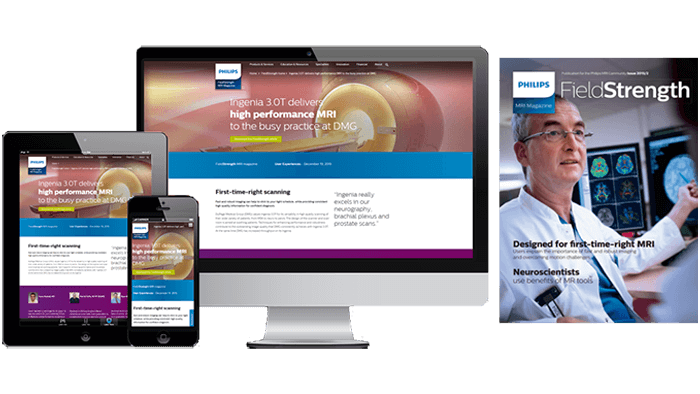FieldStrength MRI magazine
User experiences – March 2020
Compressed SENSE acceleration helps Ikazia Hospital scan more patients
When their MRI waiting times continued to increase, Ikazia Hospital Rotterdam added Compressed SENSE software to their existing MRI scanner. This technology can accelerate MRI scans. It can be used for virtually all anatomical areas and with most sequences and contrast types. The team at the Ikazia Department of Radiology is delighted with the significantly shorter examination times, without loss of image quality. The radiology staff also noticed the impact on their workflow and on their patient’s experience.
“I believe it is a must-have for every hospital”
Wim Boon, MRI technologist

Wim Boon
Has worked as MRI technologist at Ikazia Hospital for over 19 years.

Mark Stoutjesdijk, MD
Has been a radiologist at Ikazia Hospital Rotterdam for 12 years.

Marieke van Noort
Is Head of the Radiology department at Ikazia. She has been working in radiology for 32 years.
Addressing the continuously increasing waiting times for MRI
According to radiologist Mark Stoutjesdijk, the hospital was facing an enormous capacity challenge for MRI in 2018. “We have one MRI scanner and our waiting times continued to increase, which made us quite uncomfortable. We were thinking about adding a second MRI scanner, but such purchase processes typically take at least one year.” However, technologist Wim Boon learned from a Philips application specialist that new scan acceleration software could be installed on their system. “The Compressed SENSE software is also available for older MRI scanners like our Achieva 1.5T dStream. That would allow us to scan much faster* without losing our image quality.” “We immediately recognized the potential to help us scan more patients,” says Marieke van Noort, Head of Radiology at Ikazia. “During a demo, based on our own protocols, Philips showed us where we could save time, and that was very convincing. I immediately set up a working group, also involving radiologists, to thoroughly discuss the steps we would take.”
A well-planned, step-by-step implementation
In December 2018, Ikazia Hospital Rotterdam was the first hospital in the Netherlands to add Compressed SENSE software to their existing MRI scanner. Compressed SENSE is an acceleration technology that combines ‘compressed sensing’ and ‘sensitivity encoding’. It can reduce scan time for most MRI sequences and can therefore also shorten examination times. Although Compressed SENSE can also be used to improve quality, Mark Stoutjesdijk says that the team jointly made a clear decision to choose for time savings. “We could have exploited the other capabilities of Compressed SENSE, for example for increasing image quality, but that was already excellent. We really wanted to increase patient throughput, and we set specific goals for that.” “We first looked for the quick wins, the low-hanging fruit. For us, those were the knee examinations, which we had already clustered in the evenings and on Saturdays,” says Wim Boon. Mark Stoutjesdijk continues: “Together with my fellow radiologists, I mainly looked at the quality of the images in relation to the acceleration. It was important that we, as team, reached a consensus on what level of image quality was acceptable.”
“We have more than achieved our goals regarding patient throughput, it’s really beyond our expectations.”

Knee exam time halved, more patients scanned
When asked whether the waiting list had disappeared six months after installing Compressed SENSE, the team was quite amused. Mark Stoutjesdijk explains, “We have more than achieved our goals regarding patient throughput, it’s really beyond our expectations. Our knee examination times have been reduced from 30 minutes to only 15 minutes, and other examinations also take less time. On some Saturdays we scan as many as 26 to 30 patients. However, apparently increased capacity also creates new demand, so our waiting times are still the same, even though we scan many more patients.”
Patients appreciate shorter exams
Although the main aim was to save time, the shorter study duration also benefits patients, according to Wim Boon. “Especially for patients who are anxious, a shorter time in the scanner is much more comfortable. Patients who have experienced the difference between an ’old‘ exam and our current exam with Compressed SENSE indicate that they find it much more pleasant.”
Impact is broader than just scan times
Installing the acceleration software on the MRI scanner has also brought about major changes in other areas. According to Marieke van Noort: “All of a sudden we see that patient change times play a role. In the past, our examination times were so long that the time required for taking the patient on and off the table didn't matter so much. Now, switching patients needs to happen quickly – the entire workflow has changed. We have also adjusted our patient information brochures accordingly.” The introduction of Compressed SENSE also encouraged the radiologists to review the scan protocols, tells Mark Stoutjesdijk. “We went through our protocols to determine what we really needed to keep, and what we could possibly eliminate, which also resulted in time savings”, he says. “It is also important to involve the referring clinicians in such a process. After all, they need to be aware that the examination times have changed, and that they may have to request a different type of examination in some cases.” Wim Boon adds: “It is important to realize that implementing this application has had a great impact on our patient flow. My job as a technologist has really changed. If a hospital is buying Compressed SENSE, the department should be aware of the broader influence it can have.”
Caring for patients paired with productivity
Despite high pressure on the department to limit waiting times and increase productivity, the interests of patients remain paramount at Ikazia. “That’s what I like about my job,” says Wim Boon. “It is technical, but the success of an examination largely depends on how we guide patients through it – because they are often quite tense.” “Our patients should not notice that we are very busy. When patients are quite anxious or stressed, we take the time to help them feel comfortable enough to undergo the scan,” says Marieke van Noort. Wim Boon adds “The fact that examination times are now considerably shorter also helps.” “I think that in our hospital, we look carefully at how we can deliver good care in an efficient way,” says Mark Stoutjesdijk.
“We look carefully at how we can deliver good care in an efficient way”

Highly recommended to others
When asked whether they would recommend the Compressed SENSE acceleration software to others, the three interviewees were unanimously enthusiastic. “I have already been consulted by another hospital and I could only confirm that we achieved everything that we expected,” says Marieke van Noort. Wim Boon thinks that “It is a must-have for every hospital” and Mark Stoutjesdijk concludes by saying “The quality of the images is excellent. And every minute in the MRI room is valuable, so the less time spent, the better.”
*Compared to Philips scans without Compressed SENSE Results from case studies are not predictive of results in other cases. Results in other cases may vary.

Subscribe to FieldStrength
Our periodic FieldStrength MRI newsletter provides you articles on latest trends and insights, MRI best practices, clinical cases, application tips and more. Subscribe now to receive our free FieldStrength MRI newsletter via e-mail.
Stay in touch with Philips MRI

Related information

